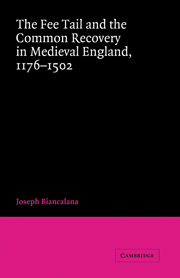Book contents
- Frontmatter
- Contents
- Acknowledgments
- List of abbreviations and abbreviated citations
- Introduction
- 1 Fee tails before De Donis
- 2 The growth of the “perpetual” entail
- 3 Living with entails
- 4 Barring the enforcement entails other than by common recovery
- 5 The origin and development of the common recovery
- 6 The common recovery in operation
- Appendix to Chapter 6
- Bibliography
- Subject and selected persons index
- Index to persons and places in Appendix to Chapter 6
2 - The growth of the “perpetual” entail
Published online by Cambridge University Press: 28 July 2009
- Frontmatter
- Contents
- Acknowledgments
- List of abbreviations and abbreviated citations
- Introduction
- 1 Fee tails before De Donis
- 2 The growth of the “perpetual” entail
- 3 Living with entails
- 4 Barring the enforcement entails other than by common recovery
- 5 The origin and development of the common recovery
- 6 The common recovery in operation
- Appendix to Chapter 6
- Bibliography
- Subject and selected persons index
- Index to persons and places in Appendix to Chapter 6
Summary
Four years before De Donis the court held that a donee of land in fee tail could alienate that land as soon as he had a child. In the absence of an alienation, neither the birth of issue to the donee, nor the survival of that issue, nor even that issue's coming into possession of the land under the grant destroyed the reversion or remainder limited after the fee tail. De Donis sought to change the law on alienations without changing the law on fee tails where there was no alienation. In both cases, however, the statute did not specify the ultimate duration of a fee tail. In the first years after its enactment the statute was read to restrain alienation by the donee of an entail whether or not he had a child. At this time, in the absence of an alienation, a fee tail was thought to last until the entry of the third heir. A petition to the Acton Burnel parliament had taken this position two years before the enactment of De Donis. By about the third decade of the fifteenth century De Donis restrained alienation by the donee and by every generation of his issue. Whether or not there had been an alienation in fact discontinuing an entail, the right to the entail lasted indefinitely – as long as there were issue of the donee. This chapter traces the growth of the indefinite entail.
- Type
- Chapter
- Information
- The Fee Tail and the Common Recovery in Medieval England1176–1502, pp. 83 - 140Publisher: Cambridge University PressPrint publication year: 2001



